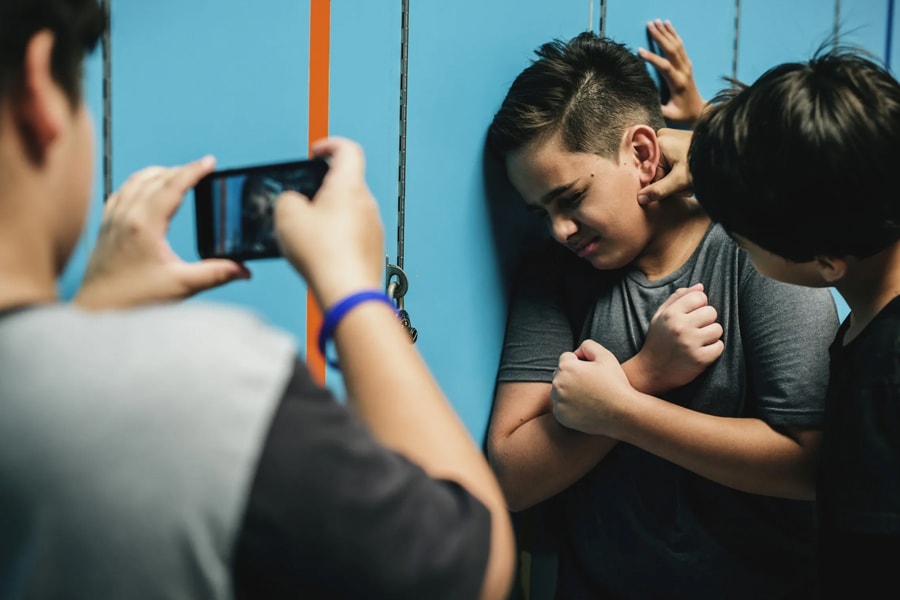
Source: DrugRehab.com
Bullying and Substance Abuse: Who It Affects and Why
Bullying transcends childish acts such as teasing, rough housing or joking around. It can be a dangerous activity with devastating physical and psychological effects. It’s a prominent risk factor for substance abuse and addiction, but the person being bullied isn’t the only one at risk.
We’re born into a world that rewards winners, but some people learn that they can rise to the top without labor. Those people knock others down to boost themselves up. They lie, cheat or steal credit for the ideas of others. Or they criticize, mock or degrade others to make themselves look better. People who repeatedly take advantage of power to intentionally harm others are bullies.
Bullying is defined as repeated, undesired and aggressive behavior that involves an inequality of power. Power can be physical, social or psychological.
The three criteria that researchers use to identify bullying behavior are:
- Intentionally aggressive behavior
- Repetition
- Power imbalance
Laura Crothers, a nationally recognized expert on childhood bullying and a psychology professor at Duquesne University, told DrugRehab.com that bullying often occurs without provocation.
“It’s not reactive or it’s not fighting back when someone else has been aggressive,” Crothers said. “There is a power differential between perpetrators and victims. The power can be physical. It can be social. It could be intellectual. It could be socio-economic or racial. The bully has more power than the victim, and the behaviors tend to be repeated over time.”
The prevalence of bullying causes many people to believe that it’s a rite of passage. Adults often justify the behavior as boys being boys, harmless gossip or immature behavior. But the behavior isn’t harmless.
“Children can’t solve bullying themselves,” Crother said. “That’s probably one of the biggest mistakes that adults make, is thinking that kids can figure it out themselves or they’ll get through it on their own. We haven’t seen that to be the case in the literature.”
Bullying can lead to physical violence, mental health problems and other life difficulties. It’s also a risk factor for substance abuse. It’s difficult to find a direct link between bullying and substance abuse because both behaviors are relatively common. More than 17 percent of children have tried an illicit drug by eighth grade, and nearly 50 percent have used an illicit drug by their senior year of high school, according to the 2016 Monitoring the Future survey. Rates of childhood alcohol use are even higher.
Comparatively, about 20 percent of high schoolers in the United States say they have been bullied on school property in the past year, and more than 15 percent say they have been bullied electronically in the past year, according to results from the CDC’s 2015 Youth Risk Behavior Survey.
“What we know is there seems to be a relationship between bullying and substance abuse, but we don’t understand the direction or the causality,” Crothers said. “It isn’t known which causes the other.”
Percent of students who reported being bullied at school, on a school bus or on the way to and from school:
| Bullied at school: | 21.5% |
| Made fun of or insulted: | 13.6% |
| Subject of rumors: | 13.2% |
| Pushed, shoved, spit on or tripped: | 6.0% |
| Excluded from activities: | 4.5% |
| Threatened with harm: | 3.9% |
| Forced to do things they didn’t want to do: | 2.2% |
| Property destroyed: | 1.6% |
Source: National Center for Education Statistics, 2013
The Relationship Between Bullying And Drug Use
Numerous studies have established a relationship between bullying, psychological health and substance abuse. Research isn’t conclusive, and bullying doesn’t affect everyone the same way. But it’s a major health problem with serious consequences.
“In terms of perpetrators, bullies themselves, there seems to be a connection between engaging in bullying and using or abusing substances,” Crothers said. “The idea is that children who are aggressive at a young age tend to seek out peers who are also non-rule governed.
“That peer environment that they seek out seems to reinforce the child’s aggression and the propensity to engage in other deviant behaviors, which may include substance use and then potentially using multiple drugs in late adolescence and into adulthood.”
It is less clear whether being bullied causes people to engage in substance abuse. One theory suggests that alcohol and other drug use is a way to cope with bullying victimization. Victims might use drugs to self-medicate symptoms of depression or anxiety that developed after being bullied. Bullies may use drugs to cope with the same mental health issues that caused them to act out.
“In terms of perpetrators, bullies themselves, there seems to be a connection between engaging in bullying and using or abusing substances. The idea is that children who are aggressive at a young age tend to seek out peers who are also non-rule governed.“
Studies also support the notion that aggressive behavior and substance use co-occur because each behavior is an attempt to cope with peer rejection. An extensive review of literature published in 2010 in School Psychology Quarterly supported the notion that risk factors for bullying and substance abuse overlap. Risk factors for bullying and bully victimization, such as social difficulties, negative community influences and academic struggles, are also risk factors for substance abuse.
Who Does Bullying Effect?
Bullying is a global problem that affects people of all ages, ethnicities, religions and cultural backgrounds. Surveys report that between 20 and 30 percent of American students are involved in bullying, either as bullies or victims, but the number of students who experience negative side effects of bullying behavior is less clear.
Consistently, boys are more likely than girls to bully or be bullied. But some research indicates that girls are more likely to experience symptoms of depression and are more vulnerable to substance abuse than boys. Researchers suspect that girls may be more vulnerable to mental health side effects because girls are more likely to engage in psychological bullying than boys.
A large-scale 2007 study of middle and high school students in a large metropolitan area found that bullying behavior differed by ethnicity. Native American and African-American students were more likely than white and Hispanic students to bully other students, and Asian students were the least likely to bully. However, all of the aforementioned ethnicities were bullied at similar rates except Native Americans, who were much more likely to be bullied.
Experts often categorize people affected by bullying as bullies, bully-victims, victims or bystanders.







